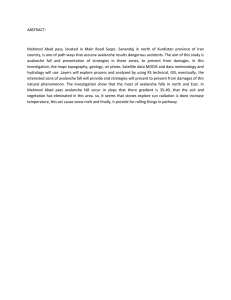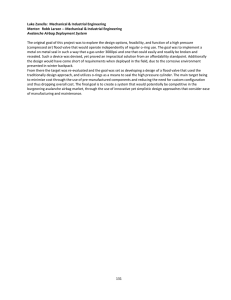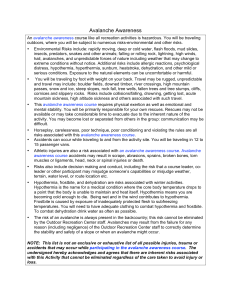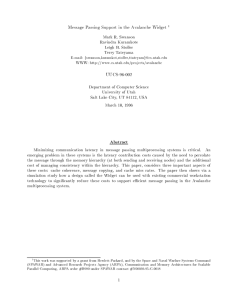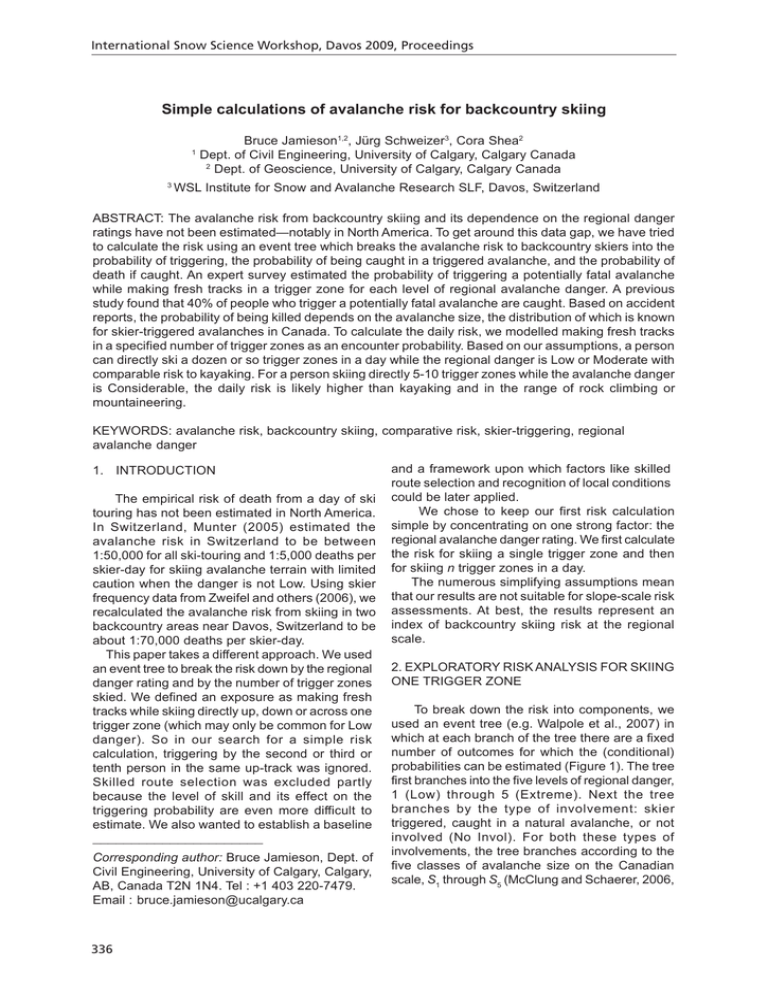
International Snow Science Workshop, Davos 2009, Proceedings
International Snow Science Workshop Davos 2009
Simple calculations of avalanche risk for backcountry skiing
1
3
Bruce Jamieson1,2, Jürg Schweizer3, Cora Shea2
Dept. of Civil Engineering, University of Calgary, Calgary Canada
2
Dept. of Geoscience, University of Calgary, Calgary Canada
WSL Institute for Snow and Avalanche Research SLF, Davos, Switzerland
ABSTRACT: The avalanche risk from backcountry skiing and its dependence on the regional danger
ratings have not been estimated—notably in North America. To get around this data gap, we have tried
to calculate the risk using an event tree which breaks the avalanche risk to backcountry skiers into the
probability of triggering, the probability of being caught in a triggered avalanche, and the probability of
death if caught. An expert survey estimated the probability of triggering a potentially fatal avalanche
while making fresh tracks in a trigger zone for each level of regional avalanche danger. A previous
study found that 40% of people who trigger a potentially fatal avalanche are caught. Based on accident
reports, the probability of being killed depends on the avalanche size, the distribution of which is known
for skier-triggered avalanches in Canada. To calculate the daily risk, we modelled making fresh tracks
in a specified number of trigger zones as an encounter probability. Based on our assumptions, a person
can directly ski a dozen or so trigger zones in a day while the regional danger is Low or Moderate with
comparable risk to kayaking. For a person skiing directly 5-10 trigger zones while the avalanche danger
is Considerable, the daily risk is likely higher than kayaking and in the range of rock climbing or
mountaineering.
KEYWORDS: avalanche risk, backcountry skiing, comparative risk, skier-triggering, regional
avalanche danger
1. INTRODUCTION
The empirical risk of death from a day of ski
touring has not been estimated in North America.
In Switzerland, Munter (2005) estimated the
avalanche risk in Switzerland to be between
1:50,000 for all ski-touring and 1:5,000 deaths per
skier-day for skiing avalanche terrain with limited
caution when the danger is not Low. Using skier
frequency data from Zweifel and others (2006), we
recalculated the avalanche risk from skiing in two
backcountry areas near Davos, Switzerland to be
about 1:70,000 deaths per skier-day.
This paper takes a different approach. We used
an event tree to break the risk down by the regional
danger rating and by the number of trigger zones
skied. We defined an exposure as making fresh
tracks while skiing directly up, down or across one
trigger zone (which may only be common for Low
danger). So in our search for a simple risk
calculation, triggering by the second or third or
tenth person in the same up-track was ignored.
Skilled route selection was excluded partly
because the level of skill and its effect on the
triggering probability are even more difficult to
estimate. We also wanted to establish a baseline
______________________
Corresponding author: Bruce Jamieson, Dept. of
Civil Engineering, University of Calgary, Calgary,
AB, Canada T2N 1N4. Tel : +1 403 220-7479.
Email : bruce.jamieson@ucalgary.ca
336
and a framework upon which factors like skilled
route selection and recognition of local conditions
could be later applied.
We chose to keep our first risk calculation
simple by concentrating on one strong factor: the
regional avalanche danger rating. We first calculate
the risk for skiing a single trigger zone and then
for skiing n trigger zones in a day.
The numerous simplifying assumptions mean
that our results are not suitable for slope-scale risk
assessments. At best, the results represent an
index of backcountry skiing risk at the regional
scale.
2. EXPLORATORY RISK ANALYSIS FOR SKIING
ONE TRIGGER ZONE
To break down the risk into components, we
used an event tree (e.g. Walpole et al., 2007) in
which at each branch of the tree there are a fixed
number of outcomes for which the (conditional)
probabilities can be estimated (Figure 1). The tree
first branches into the five levels of regional danger,
1 (Low) through 5 (Extreme). Next the tree
branches by the type of involvement: skier
triggered, caught in a natural avalanche, or not
involved (No Invol). For both these types of
involvements, the tree branches according to the
five classes of avalanche size on the Canadian
scale, S1 through S5 (McClung and Schaerer, 2006,
p. 322). For each size, the person is either caught
or not. Those caught may be either killed or not.
Some assumptions are required to simplify the
tree and its components:
• We excluded the risk from spontaneous
(natural) avalanches from our calculations for
two reasons: First, accident data show that
overall the risk due to natural avalanches is
about 10% of the risk due to human-triggered
avalanches (Tremper, 2008, p. 15). Second, the
risk of death from natural avalanches likely
increases with the danger level but data to
quantify this effect are not available. Hence, we
ignored the part of the tree for natural
avalanches.
• At higher levels of avalanche danger,
avalanches with greater destructive potential
(larger size) may be more likely but we ignore
this effect because avalanche size is not
explicitly part of the danger scale used in North
America from 1996 to 2009 (Dennis and Moore,
1996). For more on this point, see Jamieson
(2009).
• The probability of being caught (C) in a triggered
avalanche (T) is assumed to be PC|T = 0.4
(Schweizer and Lütschg, 2001), and
independent of avalanche size.
Caught
Size ?
Killed
?
?
S1
yes
S2 yes
Regional
Danger
?
1
2
3
Trig
?
yes
S3
no
S4
S5
4
5
Caught yes
by Nat
?
no
No
invol
no
no
Size Killed
?
?
S1
S2
yes
S3
no
S4
S5
Figure 1. Tree of events including the sequences that can lead to death. The levels of
regional danger are 1 (Low) through 5 (Extreme). S1 through S5 are for avalanche size on
the Canadian scale. Some branches which are
similar to others are not shown. Except for the
branches for the regional danger rating, which
is fixed for a region on a specific day, probabilities can be estimated for the other branches.
Odds of skier-triggering
International
SnowWorkshop
Science Workshop,
Davos 2009, Proceedings
International
Snow Science
Davos 2009
Percentile
75th
50 (med.)
1:10
25th
1:100
1:1
1:1,000
1:10,000
1:100,000
Low Mod Cons High Ext
Regional avalanche danger
Figure 2. For each level of the regional avalanche
danger, the graph shows the estimated odds of
skier-triggering a potentially fatal avalanche while
making fresh tracks in one trigger zone without
skilled route selection. The whisker or bar shows
the range of the middle 50% of estimates, i.e. from
the 25th to the 75th percentile (Q1 to Q3).A square
marks the median or 50 th percentile.
Working only with the upper part of the tree
for skier-triggered avalanches, two key
components need to be estimated: the probability
of triggering a potentially fatal avalanche at
danger level d, PT|d; and the probability of being
killed (K) if caught (C), PK|C. A survey of 23 experts
in North America (Jamieson, 2009) gave the
estimates for PT|d shown in Figure 2. The survey
shows a roughly 10-fold increase in triggering
odds with each level of regional danger. (For
reference, Munter (2006) estimated that the total
area of trigger spots and hence the risk would
double with each level of danger. Using data from
the Austrian Tyrol, Pfeifer (2009) found the
increase in the frequency of skier triggering to be
close to Munter’s estimate and lower than from
Jamieson’s (2009) North American survey.)
From accident data reported to the Canadian
Avalanche Association from 1984 to 1996, the
relative frequencies for size 2, 2.5 and 3 skiertriggered avalanches are 0.71, 0.18, 0.11,
respectively (Jamieson and Geldsetzer, 1996;
Table 1).
During this period, no larger skier-triggered
avalanches were reported. We exclude smaller
avalanches since, by definition, they are relatively
harmless. The same source gives the probability
of death for these sizes of avalanches (all triggers)
as 0.05, 0.17 and 0.35, respectively (Table 1).
The frequency-weighted probability of death if
caught in a skier-triggered avalanche is 0.11, the
same as reported by Schweizer and Lütschg
(2001) in a Swiss study. However for the
337
International Snow Science
Workshop,Snow
Davos
2009, Proceedings
International
Science
Workshop Davos 2009
Table 1. Frequency and death rate by avalanche size, Canada, 1984-96
Avalanche Rel. freq. of skier-triggered
Probability of death (all triggers)
size
avalanches
Assumed reporting rate for non-fatal avalanches
(Canadian)
(102 reports)
all
1 in 10
1 in 20
2
0.71
0.05
0.0052
0.0018
2.5
0.18
0.17
0.020
0.0041
3
0.11
0.35
0.051
0.011
>3
0
Probability of death if caught in a skier0.11
0.013
0.0066
triggered potentially fatal avalanche, PK|C
Canadian study, these probabilities are too high
since many non-fatal avalanches were likely not
reported as accidents. Schaerer (1987, p. 2)
estimated that about half of non-fatal avalanches
were reported. However, to estimate more
realistic fatality rates, we assumed that only 1 in
10 to 1 in 20 of potentially fatal avalanches were
reported as accidents to the Canadian Avalanche
Association between 1984 and 1996. These
assumed reporting rates result in the adjusted
probabilities shown in Columns 4 and 5 of Table
1. Hence, the frequency-weighted probability of
being killed for a skier who is caught in any
potentially fatal skier-triggered avalanche, PK|C,
likely lies between 0.0066 to 0.013 (roughly 1/
100) based on Canadian data from 1984 to 1996.
Including the assumptions noted above, the
risk of death while directly skiing one trigger zone
at danger level d is
RSKI(1, d) = PT|d PC|T PK|C
(1)
For the middle 50% of triggering odds at
Considerable danger, this calculated risk ranges
from approximately 1 death per 20,000 to 1 per
200,000 trigger zones skied, assuming that 1 in
10 non-fatal avalanches were reported.
3. EXPLORATORY RISK ANALYSIS FOR
SKIING n TRIGGER ZONES IN A DAY
Using PT|d for the probability of triggering a
potentially fatal avalanche while skiing a single
trigger zone at regional danger d (Figure 2), the
probability of not triggering such an avalanche in
n independent exposures is (1- PT|d)n. Although a
day of recreation would likely stop when a
potentially fatal avalanche was triggered, we wish
to know the probability of one or more deaths for
a day in which skiing n trigger zones is typical.
This is the encounter probability 1-(1- PT|d)n (e.g.
LaChapelle, 1964; McClung, 1999). (For Low,
Moderate and Considerable danger, the triggering
probability, P T|d , is less than 0.01 and the
encounter probability is well approximated by
338
n PT|d, which is the first non-zero term in the
McLaurin expansion. Although we do not use this
approximation in subsequent calculations, it does
explain the near-linear increase in risk with
exposures in Figure 3.)
Using the numerous assumptions described
above, we approximate the risk of death from
directly skiing n trigger zones in a day at danger
level d as
RSKI(n, d) = [1-(1-PT|d)n] PC|T PK|C
(2)
4. COMPARISON OF SKIING RISK TO RISK
DUE TO OTHER MOUNTAIN RECREATION
In Figure 3, we compared our sloping lines for
the calculated risk of death from making fresh
tracks while skiing directly n trigger zones in a
day (Eq. 2) with horizontal lines for Munter’s
(2005) estimate for skiing avalanche terrain with
limited caution when the danger is not Low
(1:5,000 per day), Sowby’s (1964) risks from
kayaking (1:20,000 for a 5-hour day), rockclimbing (1:5000 for a 5-hour day) and
mountaineering (1:1500 per day).
The area between our sloping lines includes
some of the uncertainty in the triggering
probability and in the probability of death. The
uncertainty in the triggering probability is
represented by the range from the first to third
quartile from the survey (Figure 2). The
uncertainty in the probability of death is
represented by the range of reporting rates for
non-fatal avalanches in Table 1. The lower
uncertainty line for risk is based on the first quartile
of the triggering odds from the survey and on 1 in
20 non-fatal avalanches being reported in
accident data (Q1 1:20 non-fatal). The upper
uncertainty line is based on the third quartile
(Figure 3) and on 1 in 10 non-fatal avalanches
being reported (Q3 1:10 non-fatal). The upper
uncertainty line for Moderate danger is shown as
well as both lines for Considerable and High
danger. The lines for Extreme danger are off the
graph.
International
SnowWorkshop
Science Workshop,
Davos 2009, Proceedings
International
Snow Science
Davos 2009
High
Risk of death
1:1500
danger
20
1
l
ta
-fa
10
3
mountaineering
1 day
n
1:
Q
1:2000
l
ta
fa
on
n
no
1:
Q
1:3000
rock climbing 1 day
skiing 1 day (Munter)
Cons.
danger
1:5000
1:10,000
1:20,000
kayaking 1 day
l
Q1 1:20 non-fata
Mod. danger
1
5
10
15
20
Number of trigger zones skied per day
Figure 3. Calculated risk of death by number of
trigger zones skied per day for Moderate,
Considerable and High danger. The uncertainty
zone from "Q1 1:20 non-fatal" to "Q3 1:10 nonfatal" is explained in the text. For comparison,
daily ri sk f rom k ayaking, r ock c limbing a nd
mountaineering (Sowby, 1964) as well as skiing
avalanche terrain with limited caution (Munter ,
2005) are shown as horizontal lines.
5. SOME TENTATIVE INTERPRETATIONS
In the following interpretations, various
simplifying assumptions including those outlined
in this paper have been made, and "skiing" means
making fresh tracks while directly skiing trigger
zones in the backcountry:
• The calculated avalanche risk from skiing
increases roughly 10-fold with each level of
regional avalanche danger. This follows from
the approximate 10-fold increase in triggering
probability when the regional danger increases
by one level (Figure 2, based on the survey).
• As indicated by the almost straight lines in
Figure 3, the skiing risk at Moderate or
Considerable danger is roughly proportional to
the number of exposures. This is also true for
Low danger although the uncertainty lines are
not shown.
• The calculated risk from skiing fewer than 20
trigger zones at Moderate danger is roughly
comparable to a published risk for kayaking.
The calculated risk for directly skiing fewer than
20 trigger zones while the regional avalanche
danger is Low (not shown) tends to be lower
than for kayaking.
• At Considerable danger, the risk from directly
skiing 10 or more trigger zones per day is likely
greater than kayaking and more in the range of
risk while rock climbing or mountaineering
(~1960 data). However, there is considerable
uncertainty in this comparison.
• Munter’s (2005) estimate for skiing avalanche
terrain with limited caution when the danger is
not Low is in the middle of the range that we
calculated for directly skiing 5-15 trigger zones
at Considerable danger.
• At High danger the calculated risk from directly
skiing more than about five trigger zones per
day is at least as high as mountaineering.
6. DISCUSSION AND SUMMARY
Our assumption of directly skiing trigger zones
tends to make our estimates of avalanche risk
higher than for typical backcountry skiing. The
exception is for Low danger, for which we observe
many people skiing directly down trigger zones.
At Considerable avalanche danger, skilled
route selection—which requires experience—
may be important to reduce the risk to a level
comparable to kayaking or rock climbing.
For these calculations, there is an underlying
assumption that trigger points are randomly
distributed on avalanche slopes in a forecast
region. For a skier who skis different avalanche
slopes without skilled route selection on each run,
and is thereby exposed to many different trigger
zones, the assumption may be reasonable.
However, the risk calculations probably
overestimate the avalanche risk for a person
repeatedly skiing the same few trigger zones
without skilled route selection.
The uncertainty lines for avalanche risk in
Figure 3 are based on simple assumptions of
uncertainty and are not upper and lower limits. In
the future, we plan to model uncertainty with a
Monte-Carlo simulation.
We have made many assumptions to obtain
these simple calculations of avalanche risk for
various levels of regional avalanche danger.
Hopefully, the event tree will provide a framework
for more realistic calculations. We hope the tree
can be modified to include other factors or
observations including those used in decision
support schemes (e.g. terrain ratings) and in
bulletins (e.g. avalanche type). Also, the experts
who responded to the survey made many
suggestions such as including avalanche size,
the area of the forecast region, and skilled route
selection in a future survey of triggering odds.
The triggering odds for a snowmobiler are
likely higher than for a skier since snowmobiles
are likely more effective for initiating fractures in
weak layers (T. Exner, in preparation). Also,
snowmobilers can access more trigger zones in
a day than a self-propelled backcountry skier or
snowboarder.
339
International Snow Science
Workshop,Snow
Davos
2009, Proceedings
International
Science
Workshop Davos 2009
In time it may be possible to validate some of
our calculations. For the present, we invite
experienced recreationists to comment on the
comparison of our calculated skiing risk with other
recreational risks in Figure 3.
Our numerous assumptions mean that our
calculations are exploratory and not suitable for
risk assessments, especially on the scale of
individual slopes or ski runs. We hope these
exploratory calculations promote discussion,
better analyses, better estimates of avalanche risk
during winter recreation and, ultimately, better
informed decisions.
ACKNOWLEDGEMENTS
Many thanks to the respondents who
completed the difficult survey of triggering odds,
to Grant Statham, Chris Stethem, Pascal Haegeli,
Robert C. Lee and Karl Birkeland for their advice,
and to Kisa Elmer for proofreading. For financial
support, we are grateful to the Natural Sciences
and Engineering Research Council of Canada,
HeliCat Canada, the Canadian Avalanche
Association, Mike Wiegele Helicopter Skiing, Teck
Mining Company, Canada West Ski Areas
Association, the Association of Canadian
Mountain Guides, Backcountry Lodges of British
Columbia, and the Canadian Ski Guides
Association.
REFERENCES
Dennis, A., M. Moore. 1996: Evolution of public
avalanche information: The North American
experience with avalanche danger rating
levels. Proc. Internat. Snow Science
Workshop, Banff, Alberta, 1996, 60-72.
Exner, T. In preparation. Field studies of
snowpack stress and deformation due to
surface loads and temperature effects. PhD
thesis, Dept. of Geoscience, University of
Calgary, Calgary, Canada.
Jamieson, B. 2009. Regional danger ratings
and the odds of triggering a potentially fatal
avalanche, avalanche.ca - The Journal of
Canada's Avalanche Community, 89: 56-69.
Also in press for The Avalanche Review.
LaChapelle, E.R. 1966. Encounter probability
for avalanche damage. USDA Forest
Service, Misc. Rep. 10.
340
McClung, D.M. 1999. The encounter probability
for mountain slope hazards. Can. Geotech.
J. 36: 1-2.
McClung, D.M., P.A. Schaerer. 2006. The
Avalanche Handbook, 3rd edition. The
Mountaineers Books, Seattle, Washington,
USA.
Munter, W. 2005. Formel statt Floskel.
Bergundsteigen - Zeitschrift fuer
Risikomanagement im Bergsport.
Oesterreichischer Alpenverein, Innsbruck,
Austria, 14(4): 38-41.
Munter, W. 2006. 3x3 Avalanches - La gestion
du risque dans les sports d’hiver. Éd. Club
Alpin Suisse
Pfeifer, C. 2009. On probabilities of avalanches
triggered by alpine skiers. An empirically
driven decision strategy for backcountry
skiers based on these probabilities. Natural
Hazards 48: 425–438.
Schaerer, P.A. 1987. Avalanche Accidents in
Canada III. A Selection of Case Histories,
1978-1984, National Research Council of
Canada, Inst. Res. Construction, No. 1468,
NRCC publication 27950.
Schweizer, J., M. Lütschg. 2001.
Characteristics of human-triggered
avalanches. Cold Reg Sci Technol. 33:
147–162
Sowby, F.D. 1964. Radiation and other risks. In
F.J. Neary (ed.) Proc. Symposium on the
Transporting of Radioactive Materials,
Bournemouth, 13-15 April 1964, H.M.
Stationary Office, London, UK.
Tremper, B. 2008. Staying Alive in Avalanche
Terrain, 2nd edition. The Mountaineers
Books, Seattle, Washington, USA.
Walpole, R.E., R.H. Myers, S.L. Myers, K. Ye.
2007. Probability and Statistics for
Engineers and Scientists, eighth edition.
Pearson Prentice Hall, Upper Saddle River,
New Jersey, USA.
Zweifel, B., A. Raez, T. Stucki. 2006. Avalanche
risk for recreationists in backcountry and in
off-piste area: Surveying methods and pilot
study at Davos, Switzerland. In Gleason, A.
(ed.) Proc. International Snow Science
Workshop 2006, Telluride CO., 733-741.

